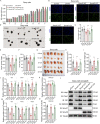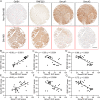Smurf1 and Smurf2 mediated polyubiquitination and degradation of RNF220 suppresses Shh-group medulloblastoma
- PMID: 37537194
- PMCID: PMC10400574
- DOI: 10.1038/s41419-023-06025-2
Smurf1 and Smurf2 mediated polyubiquitination and degradation of RNF220 suppresses Shh-group medulloblastoma
Abstract
Sonic hedgehog (Shh)-group medulloblastoma (MB) (Shh-MB) encompasses a clinically and molecularly distinct group of cancers originating from the developing nervous system with aberrant high Shh signaling as a causative driver. We recently reported that RNF220 is required for sustained high Shh signaling during Shh-MB progression; however, how high RNF220 expression is achieved in Shh-MB is still unclear. In this study, we found that the ubiquitin E3 ligases Smurf1 and Smurf2 interact with RNF220, and target it for polyubiquitination and degradation. In MB cells, knockdown or overexpression of Smurf1 or Smurf2 promotes or inhibits cell proliferation, colony formation and xenograft growth, respectively, by controlling RNF220 protein levels, and thus modulating Shh signaling. Furthermore, in clinical human MB samples, the protein levels of Smurf1 or Smurf2 were negatively correlated with those of RNF220 or GAB1, a Shh-MB marker. Overall, this study highlights the importance of the Smurf1- and Smurf2-RNF220 axes during the pathogenesis of Shh-MB and provides new therapeutic targets for Shh-MB treatment.
© 2023. The Author(s).
Conflict of interest statement
The authors declare no competing interests.
Figures







Similar articles
-
RNF220 is required for cerebellum development and regulates medulloblastoma progression through epigenetic modulation of Shh signaling.Development. 2020 Jun 15;147(21):dev188078. doi: 10.1242/dev.188078. Development. 2020. PMID: 32376680
-
Sequential stabilization of RNF220 by RLIM and ZC4H2 during cerebellum development and Shh-group medulloblastoma progression.J Mol Cell Biol. 2022 Apr 5;14(1):mjab082. doi: 10.1093/jmcb/mjab082. J Mol Cell Biol. 2022. PMID: 35040952 Free PMC article.
-
RNF220-mediated ubiquitination promotes aggresomal accumulation and autophagic degradation of cytoplasmic Gli via HDAC6.Biochem Biophys Res Commun. 2021 Jun 11;557:323-328. doi: 10.1016/j.bbrc.2021.03.156. Epub 2021 Apr 22. Biochem Biophys Res Commun. 2021. PMID: 33895473
-
The many faces of the E3 ubiquitin ligase, RNF220, in neural development and beyond.Dev Growth Differ. 2022 Feb;64(2):98-105. doi: 10.1111/dgd.12756. Epub 2021 Nov 11. Dev Growth Differ. 2022. PMID: 34716995 Review.
-
Restore the brake on tumor progression.Biochem Pharmacol. 2017 Aug 15;138:1-6. doi: 10.1016/j.bcp.2017.04.003. Epub 2017 Apr 5. Biochem Pharmacol. 2017. PMID: 28389227 Free PMC article. Review.
Cited by
-
Alternative spliceosomal protein Eftud2 mediated Kif3a exon skipping promotes SHH-subgroup medulloblastoma progression.Cell Death Differ. 2025 Apr 24. doi: 10.1038/s41418-025-01512-9. Online ahead of print. Cell Death Differ. 2025. PMID: 40275081
-
SMURF1 and SMURF2 directly target GLI1 for ubiquitination and proteasome-dependent degradation.Cell Death Discov. 2024 Dec 18;10(1):498. doi: 10.1038/s41420-024-02260-4. Cell Death Discov. 2024. PMID: 39695131 Free PMC article.
References
Publication types
MeSH terms
Substances
LinkOut - more resources
Full Text Sources
Molecular Biology Databases
Miscellaneous

